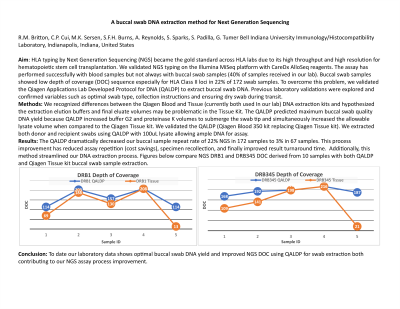Back

(P603) A buccal swab DNA extraction method for Next Generation Sequencing
Location: Platinum Ballroom

- MK
Poster Presenter(s)
Aim: HLA typing by Next Generation Sequencing (NGS) became the gold standard across HLA labs due to its high throughput and high resolution for hematopoietic stem cell transplantation. We validated NGS typing on the Illumina MiSeq platform with CareDx AlloSeq reagents. The assay has performed successfully with blood samples but not always with buccal swab samples (40% of samples received in our lab). Buccal swab samples showed low depth of coverage (DOC) sequence especially for HLA Class II loci in 22% of 172 swab samples. To overcome this problem, we validated the Qiagen Applications Lab Developed Protocol for DNA (QALDP) to extract buccal swab DNA. Previous laboratory validations were explored and confirmed variables such as optimal swab type, collection instructions and ensuring dry swab during transit.
Method: We recognized differences between the Qiagen Blood and Tissue (currently both used In our lab) DNA extraction kits and hypothesized the extraction elution buffers and final eluate volumes may be problematic in the Tissue Kit. The QALDP predicted maximum buccal swab quality DNA yield because QALDP increased buffer G2 and proteinase K volumes to submerge the swab tip and simultaneously increased the allowable lysate volume when compared to the Qiagen Tissue kit. We validated the QALDP (Qiagen Blood 350 kit replacing Qiagen Tissue kit). We extracted both donor and recipient swabs using QALDP with 100uL lysate allowing ample DNA for assay.
Results: The QALDP dramatically decreased our buccal sample repeat rate of 22% NGS in 172 samples to 3% in 67 samples. This process improvement has reduced assay repetition (cost savings), specimen recollection, and finally improved result turnaround time. Additionally, this method streamlined our DNA extraction process. Figures 1 and 2 compare NGS DRB1 and DRB345 DOC derived from 10 samples with both QALDP and Qiagen Tissue kit buccal swab sample extraction.
Conclusion: To date our laboratory data shows optimal buccal swab DNA yield and improved NGS DOC using QALDP for swab extraction both contributing to our NGS assay process improvement.
Method: We recognized differences between the Qiagen Blood and Tissue (currently both used In our lab) DNA extraction kits and hypothesized the extraction elution buffers and final eluate volumes may be problematic in the Tissue Kit. The QALDP predicted maximum buccal swab quality DNA yield because QALDP increased buffer G2 and proteinase K volumes to submerge the swab tip and simultaneously increased the allowable lysate volume when compared to the Qiagen Tissue kit. We validated the QALDP (Qiagen Blood 350 kit replacing Qiagen Tissue kit). We extracted both donor and recipient swabs using QALDP with 100uL lysate allowing ample DNA for assay.
Results: The QALDP dramatically decreased our buccal sample repeat rate of 22% NGS in 172 samples to 3% in 67 samples. This process improvement has reduced assay repetition (cost savings), specimen recollection, and finally improved result turnaround time. Additionally, this method streamlined our DNA extraction process. Figures 1 and 2 compare NGS DRB1 and DRB345 DOC derived from 10 samples with both QALDP and Qiagen Tissue kit buccal swab sample extraction.
Conclusion: To date our laboratory data shows optimal buccal swab DNA yield and improved NGS DOC using QALDP for swab extraction both contributing to our NGS assay process improvement.
